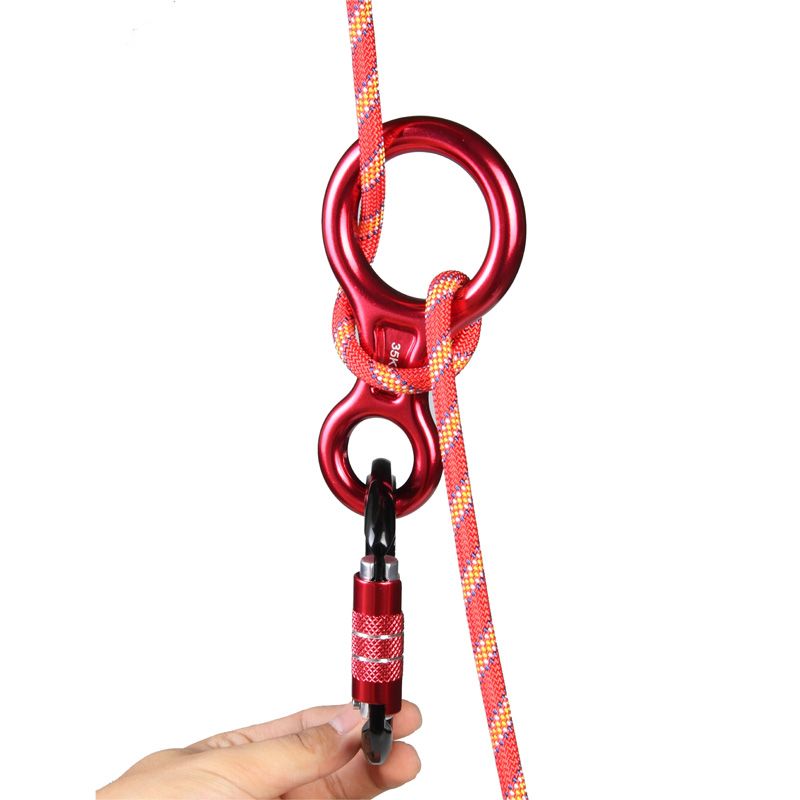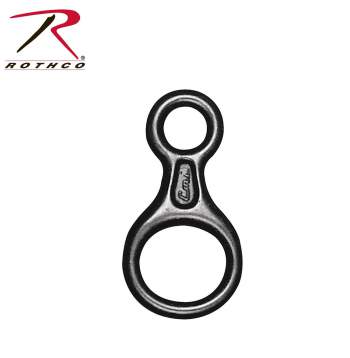Rock-climbing equipment#Figure eight
The figure eight is a descender and belay device that is primarily used for climbing, but also in other activities, is where abseil. In its most common form it consists of a 15 to 20 cm large eight cast aluminum. There are also numerous special forms whose shape is optimized for a specific purpose out.
- 2.1 General issues
- 2.2 Application Error
Abseiling
Rock climbing
The climbing rope is routed around the figure of eight and by the large eyelet that the friction of the rope is sufficient to slow the climber so that a safe descent is possible. The descender is mounted with its small eyelet with a carabiner to the harness.
Abseiling with the figure of eight is now considered universal and safe Abseilmethode and has older techniques such as the Dülfersitz displaced.
Canyoning
Canyoning the descender is also used for abseiling. However, the braking effect is significantly greater in a wet rope. This is offset by the fact that the rope is placed differently to the descender to produce less friction. The line drawn through the large ring strap is not wrapped around the crossbar, but hung in the carbine, which also depends on the roller itself. This technique, which is also referred to as "fast eight", also prevents a turning of the rope to the anchor knot, and thus an unintentional locking of the rope.
Climbing backup
Besides using abseiling aft also found a large spread as a backup device, especially when sport climbing. In this case, the friction of the rope and the descender is used in order to reduce the fall energy, and the resulting forces. Although now replaced increasingly by the more modern tubes and automatic belay devices like the Grigri, you sometimes still hits him in each region quite frequently.
General issues
Despite its widespread use, there are when using the Abseilachters as a backup device some limitations and criticisms:
Thus, the roller reaches its maximum braking force, braking and load cable need to run in opposite directions from the large eye of the rowing eight. Even in this case the roller compared to other security devices has a small braking effect of 2.0 to 2.5 kN. The Munter hitch lock ( HMS) developed in comparison with the same cable path 2.7 kN braking force. This causes the belayer at the aft requires more hand strength to achieve the same braking force, which is why children and inexperienced climbers is discouraged from securing the eighth.
Running both strands of rope in the same direction from the back out, so the braking force is only 1.3 to 1.5 kN ( 3.5 kN at HMS in the same configuration). This situation can occur when using the rowing eight in multi-pitch routes in two cases:
- If the roller used by the lead climber to secure a belayed from above, so the safety rope from the bottom runs into the eights and the brake cable down and out again. In this way, the forces of 1.6 to 2.0 kN, which can occur during a fall of Nachsteigers, will no longer be kept under certain circumstances. The necessary for a greater braking power cable course in the aft would be produced theoretically by the brake cable would be held up. However, this attitude is contrary to human reflexes in such a situation and would also be kept under shock loading hardly. For this reason, the descender should not be used to secure a climbers.
- The same situation occurs with a factor -2 fall of the lead climber directly to the stand backup because the lead climber on stand by here crashes down. This case is much more dangerous than the fall of a Nachsteigers because the resulting forces are significantly larger and such a fall is almost impossible to brake with the eighth.
These two situations when saving in multi-pitch routes can be circumvented by the belayer the safety rope to a belay above the rowing eight - a so-called dummy Runner - mounts, which prevents the roller is charged to train down .. Since this is not always is possible and the forgetting of this additional intermediate backup provides a further source of danger, the aft is as a backup device for multi-pitch routes rather unsuitable.
In addition to these problems the roller can cause the only backup device in addition to the half hitch backup twists and kinking. In addition, the handling with two ropes in the use of half or twin ropes can be very exhausting, so an optimal dynamic belay is no longer guaranteed. Also by this application is not recommended.
For the above reasons, the roller as a backup device only for ( advanced ) climbers, secure from the ground, a sensible option. Despite the criticism of the eighth, as a device for personal backup ( in which the device is mounted on the harness of the climber ) generally rated as suitable for securing single pitch in by modern textbooks.
Application Error
In addition to general problems, there is - as with all safety devices - typical application error. When eight are:
- The brake hand is when braking, as requested below the device. The device can thus not the normal, already develop low brake force anyway in comparison.
- During the Seileinziehens the hand brake engages both strands of rope rather than remain alone on the brake cable. This causes the hand brake in case of load remaining at the top decreases and the braking action accordingly.
- The roller is offset to the gate of the snap hook and acts in case of a load as a lever which destroys the safety lock the carabiner. Thus, the carbine can open and unhook the eighth. This danger can be eliminated if the roller is prepared with a rubber band or tape strips so that he has no room to move in the carbine. Alternatively, a carabiner can be used which prevents tilting of the rowing eight at the seal. This is the case for example in the DMM Belay Master.
- The screw- rotating in the belay loop the harness and is loaded transversely. This creates an increased risk of fracture carbine. Also, this source of danger can be eliminated by a screw- tensioned tape across the tape, which prevents rotation of the carabiner in the belay loop. Alternatively carabiner islets used with an additional twist. It usually holds a wire gate carabiner at one end of the belay loop securely, so that the carabiner rotates automatically when loaded in the correct longitudinal position.
Also in the correct application of the eight cuts in comparison not as good. Although the roller is a commonly used security device that can recent research in terms of correct operation doubts about his safety arise. Thus resulted in a large study in German climbing gyms that the aft significantly worse with an operator error rate of 40 % cuts than the next best devices Grigri and Tube with 28.6%.








